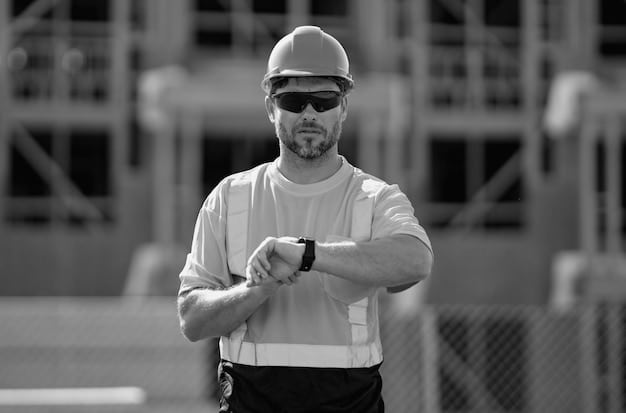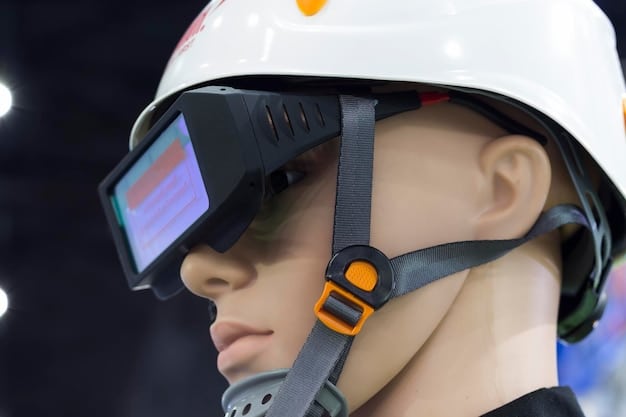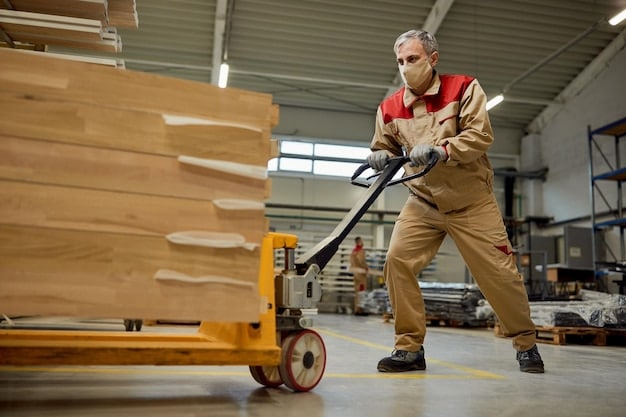Wearable Tech: Enhancing Workplace Safety in US Industries

New wearable technologies are enhancing workplace safety in US industries by providing real-time monitoring of workers’ health and environment, enabling proactive interventions and reducing workplace accidents.
The landscape of workplace safety is undergoing a significant transformation, thanks to the emergence of innovative wearable technologies. But, what new wearable technologies are enhancing workplace safety in US industries? These devices are not just gadgets; they are sophisticated tools designed to monitor worker health, environmental conditions, and potential hazards, offering real-time data and alerts to prevent accidents and injuries.
The Rise of Wearable Technology in Occupational Safety
Wearable technology has moved beyond fitness trackers and smartwatches to become a crucial component in enhancing occupational safety. These devices are designed to be worn on the body, providing continuous monitoring and real-time data analysis. This data can be used to identify potential hazards, improve worker well-being, and prevent accidents.
Key Benefits of Wearable Tech in Safety
Wearable technology offers several key benefits that make it an attractive solution for enhancing workplace safety. These include real-time monitoring, immediate alerts, and improved data collection. By providing these benefits, wearable tech can significantly reduce workplace accidents and improve overall safety outcomes.
- Real-Time Monitoring: Wearables allow for continuous monitoring of workers’ vital signs, environmental conditions, and proximity to hazards.
- Immediate Alerts: These devices can provide immediate alerts to workers and supervisors when a potential hazard is detected, allowing for quick intervention.
- Improved Data Collection: Wearable tech enables the collection of valuable data that can be used to identify trends, assess risks, and improve safety protocols.
The adoption of wearable technology in occupational safety is driven by the need to create safer working environments and reduce the incidence of workplace accidents and injuries. As technology continues to advance, wearable devices are becoming more sophisticated, reliable, and cost-effective, making them an increasingly viable option for businesses across various industries.
Smart Helmets: Protecting Workers from Head Injuries
Smart helmets are one of the most popular and effective wearable technologies for enhancing workplace safety. These helmets are equipped with sensors, cameras, and communication devices that provide real-time information about the worker’s environment and physical condition. They are particularly useful in construction, mining, and manufacturing industries, where head injuries are a significant concern.

Features of Smart Helmets
Smart helmets come with a range of features designed to protect workers and improve their situational awareness. These features include impact detection, environmental monitoring, and communication capabilities. By integrating these functionalities, smart helmets offer a comprehensive solution for head protection and safety management.
- Impact Detection: Sensors in the helmet can detect impacts and alert supervisors, allowing for immediate medical attention if needed.
- Environmental Monitoring: Smart helmets can monitor temperature, humidity, and air quality, alerting workers to potentially hazardous conditions.
- Communication Capabilities: Integrated communication devices allow workers to communicate with supervisors and colleagues, improving coordination and response times.
The use of smart helmets can significantly reduce the risk of head injuries in the workplace. By providing real-time data and alerts, these helmets enable workers to take proactive measures to avoid accidents and protect themselves from potential hazards. Additionally, the data collected by smart helmets can be used to identify trends and improve safety protocols.
Exoskeletons: Reducing Physical Strain and Injuries
Exoskeletons are wearable devices designed to support and enhance the physical capabilities of workers. These devices can reduce physical strain, prevent injuries, and improve productivity. They are particularly useful in industries that require repetitive tasks, heavy lifting, and awkward postures, such as manufacturing, logistics, and construction.
Types of Exoskeletons
There are two main types of exoskeletons: passive and active. Passive exoskeletons use springs and levers to redistribute weight and reduce strain, while active exoskeletons use motors and sensors to provide additional support and power. Each type offers different benefits and is suitable for different applications.
Passive exoskeletons are typically used for tasks that involve repetitive lifting and bending. They can reduce the amount of force required to perform these tasks, minimizing the risk of muscle strain and back injuries. Active exoskeletons, on the other hand, are used for tasks that require sustained strength and endurance. They can provide additional power to the worker, allowing them to lift heavier objects and perform tasks for longer periods without fatigue.

The implementation of exoskeletons can significantly reduce the incidence of musculoskeletal disorders (MSDs) in the workplace. By providing support and reducing strain, these devices enable workers to perform their tasks more safely and efficiently. Additionally, exoskeletons can improve worker comfort and reduce fatigue, leading to increased productivity and job satisfaction.
Wearable Sensors: Monitoring Worker Health and Environment
Wearable sensors are small, lightweight devices that can be worn on the body to monitor various health and environmental parameters. These sensors can track vital signs, detect exposure to hazardous substances, and monitor environmental conditions. They are used in a wide range of industries, including healthcare, manufacturing, and environmental monitoring.
Applications of Wearable Sensors
Wearable sensors have numerous applications in workplace safety. They can be used to monitor worker fatigue, detect exposure to toxic chemicals, and track environmental conditions. By providing real-time data and alerts, these sensors enable workers and supervisors to take proactive measures to prevent accidents and protect their health.
- Fatigue Monitoring: Sensors can track heart rate variability and other physiological indicators to detect fatigue and alert workers to take breaks.
- Exposure Detection: These devices can detect exposure to hazardous substances, such as gases and chemicals, providing immediate alerts to workers and supervisors.
- Environmental Monitoring: Wearable sensors can monitor temperature, humidity, and air quality, alerting workers to potentially hazardous environmental conditions.
The use of wearable sensors can significantly improve worker health and safety. By providing real-time data and alerts, these sensors enable workers to take proactive measures to avoid exposure to hazardous substances and prevent accidents. Additionally, the data collected by wearable sensors can be used to identify trends and improve safety protocols.
Smartwatches and Fitness Trackers: Integrating Health and Safety
Smartwatches and fitness trackers are increasingly being used to promote health and safety in the workplace. These devices can track activity levels, monitor heart rate, and provide alerts for sedentary behavior. They are particularly useful in industries that require long hours of sitting or standing, such as office work, transportation, and customer service.
Benefits of Smartwatches and Fitness Trackers
Smartwatches and fitness trackers offer several benefits for workplace health and safety. They can promote physical activity, reduce sedentary behavior, and provide alerts for potential health issues. By encouraging healthy habits, these devices can improve worker well-being and reduce the risk of chronic diseases.
One of the key benefits of smartwatches and fitness trackers is their ability to promote physical activity. These devices can track steps, distance traveled, and calories burned, encouraging workers to be more active throughout the day. Additionally, they can provide reminders to get up and move around, reducing the risk of sedentary behavior. Smartwatches and fitness trackers can also monitor heart rate and provide alerts for potential health issues, such as irregular heartbeats or high blood pressure. By detecting these issues early, workers can seek medical attention and prevent more serious health problems.
The integration of smartwatches and fitness trackers into workplace wellness programs can significantly improve worker health and safety. By encouraging healthy habits and providing alerts for potential health issues, these devices can help workers stay healthy, productive, and engaged.
The Future of Wearable Safety Technology
The future of wearable safety technology is promising, with ongoing advancements in sensor technology, data analytics, and artificial intelligence. These advancements are paving the way for more sophisticated and effective wearable devices that can enhance workplace safety and protect workers from potential hazards.
Emerging Trends in Wearable Safety Tech
Several emerging trends are shaping the future of wearable safety technology. These include the integration of AI, the development of more advanced sensors, and the expansion of wearable applications. By embracing these trends, businesses can create safer and more productive working environments.
- AI Integration: AI algorithms can analyze data collected by wearable devices to identify patterns, predict potential hazards, and provide personalized safety recommendations.
- Advanced Sensors: New sensors are being developed to monitor a wider range of health and environmental parameters, providing more comprehensive data for safety management.
- Expanded Applications: Wearable technology is being used in an increasing number of industries and applications, from construction and manufacturing to healthcare and transportation.
The continued development and adoption of wearable safety technology will play a crucial role in enhancing workplace safety and protecting workers from potential hazards. By embracing these innovative solutions, businesses can create safer, healthier, and more productive working environments.
| Key Point | Brief Description |
|---|---|
| ⛑️ Smart Helmets | Protect workers from head injuries with impact detection and environmental monitoring. |
| 💪 Exoskeletons | Reduce physical strain and prevent injuries in tasks requiring heavy lifting. |
| 🩺 Wearable Sensors | Monitor worker health and environmental conditions to prevent accidents. |
| ⌚ Smartwatches | Promote health and safety by tracking activity levels and providing health alerts. |
Frequently Asked Questions
▼
Wearable technology can help prevent head injuries (using smart helmets), musculoskeletal disorders (using exoskeletons), and injuries related to fatigue or exposure to hazardous substances (using wearable sensors).
▼
Smart helmets improve workplace safety by providing impact detection, environmental monitoring, and communication capabilities, allowing workers to respond quickly to potential hazards.
▼
Exoskeletons reduce physical strain, prevent injuries, and improve productivity by supporting workers during repetitive tasks, heavy lifting, and awkward postures.
▼
Wearable sensors monitor worker health by tracking vital signs, detecting exposure to hazardous substances, and alerting workers to potential health issues, enabling proactive interventions.
▼
Smartwatches promote health and safety by tracking activity levels, monitoring heart rate, and providing alerts for sedentary behavior, encouraging healthy habits and improving worker well-being.
Conclusion
In conclusion, the integration of new wearable technologies is revolutionizing workplace safety in US industries. From smart helmets and exoskeletons to wearable sensors and smartwatches, these devices are providing real-time data, immediate alerts, and improved monitoring capabilities that are significantly reducing workplace accidents and injuries.





